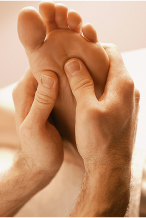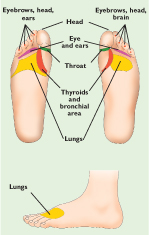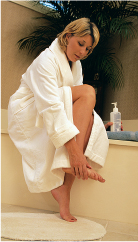Strengthening reflexology
Reflexology has been used as a natural healing art for thousands of years in China, Malaysia and India. The technique helps overall health and relieves aches and pains by applying pressure on the edges and base of the feet, toes and hands. Reflexology can help to prevent the flu and to relieve respiratory problems.

+ This natural healing art is based on the principle and study that there are reflexes in the body -especially in the feet and hands- that correspond to the body's organs and glands. Applying stimulation and pressure to the feet or hands, can affect the health of other parts of the body. Modern reflexology is based on the work of US physician William Fitzgerald, who in the early 20th century developed the ancient Oriental healing art of using pressure to relieve pains into a usable diagnostic therapy.
Reflexology is not an exact science, but has been proven through practice to give positive results. You don't need to be a specialist to give these relaxing massages, you can practice them with someone else or on yourself.
The following massages are a good way to fight stress and to stimulate blood flow to the affected organs. There are specific massages to help alleviate excess mucus, headaches, coughs and other symptoms brought on by colds, flu and bronchitis.
ON THE HANDS

There are also reflex points on the hands. The following exercise is the perfect massage or self-massage to provide relief for headaches. With the index finger and thumb, massage the soft part of the palm of your hand, applying firm pressure with the two fingers and concentrating on the side of the hand that corresponds to where your pain is coming from. Pregnant women should avoid this exercise, because it is the same reflex point to stimulate giving birth.
IMPORTANT
For colds, flu and bronchitis, it's good to give yourself a massage to release tension and to increase sensibility in the feet. This will help to more accurately stimulate pressure points on the bottom and edges of the feet, focusing on the most important points such as the head, eyes, ears, throat, and lungs, as indicated in the diagram.

HEADACHES
To treat headaches there are specific massages on the feet.
Start by using firm circular movements with your thumb on your big toe, which will help to loosen the neck. Next, apply strong pressure over the reflex areas that correspond to the head (see above diagrams), using your thumb.
ON THE FEET
ASTHMA AND BRONCHITIS
Reflexology can be very useful in the treatment of asthma, bronchitis and smokers’ cough. Using your fingertips, apply steady, penetrating pressure to the points that correspond to the lungs.

EARACHES
To relief earaches apply pressure to the points on the foot that correspond to the ears, behind the toes.

SAFETY
Although reflexology is not an aggressive treatment, it can present side effects with certain conditions: pregnancy (especially if there is risk of miscarriage), fever, serious diseases, problems that require emergency surgery, gangrene, injuries or foot conditions, and serious infections.
This pressure can cause you some discomfort, but you should continue with the massage and the discomfort will pass. Continue applying pressure with your thumb lower and on the tip of your big toe.
EXCESS MUCUS
When you have a cold or cough and a lot of mucus and pressure in the sinus area, massaging the areas that correspond to the suprarenal gland and the ileac valve can help you feel better.
COMMON COLD
To treat a cold with reflexology it's good to apply pressure to all of the reflex areas that correspond to the head. Concentrate the pressure to the points that correspond to the nose, throat, lungs, eyes, ears and the sinuses.
WHAT IS A REFLEXOLOGY SESSION LIKE?
Normally a reflexology session lasts for half an hour, depending on the sensibility of the feet. One session per week is recommended when beginning treatment, although you can decide how often you use reflexology depending on your needs.

- • A session begins with a deep cleansing of the feet.
- • Next, try to clear your mind by closing your eyes, thinking nice thoughts and breathing through the nose deeply at least three times.
- • To get your muscles ready, the practitioner will massage the entire sole of your foot and your ankle. Then the reflexologist will roll your ankle and gently massage each toe.
- • The practitioner will then ask you what problems you are having and examine each foot. This is done in order to know what pressure points to work on. The reflexologist will press on each of the reflex points, one by one.
- • The body is divided into ten longitudinal zones, five zones on each side. The organ in that specific zone will correspond to that same longitudinal zone on the foot.
- • The stimulating pressure can be very comforting, nevertheless stimulating some pressure points can cause discomfort. This response will help the practitioner find corporal imbalances and design a suitable massage session to treat them.
- • Sessions can be so relaxing that some patients might fall asleep, while others might feel energized and rejuvenated. It's best to follow what your body feels and needs, whether it is to move around or rest.
- • In general, reflexology doesn't present any side-effects. However, when begining treatment some patients may feel as if symptoms get worse. This is known as “crisis when curing”. Crisis occurs when the process of detoxifying takes place in the body. You don't need to worry, this is a good sign, it means that the treatment is working effectively on your body.

Comment about this article, ask questions, or add new information about this topic: